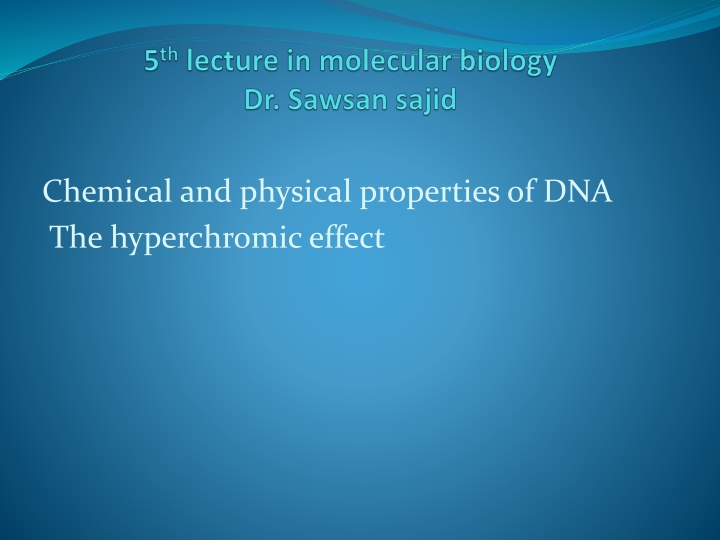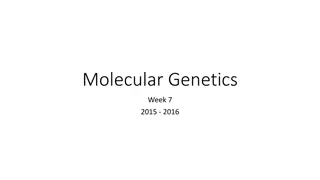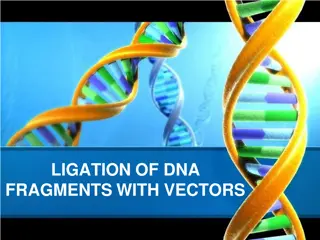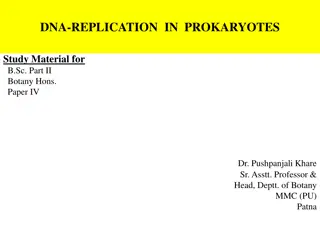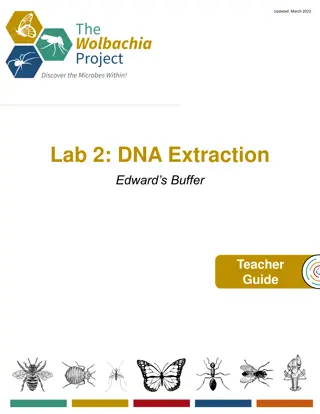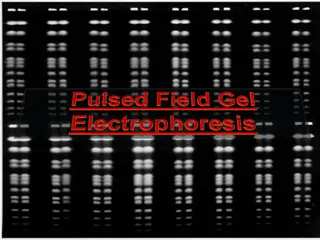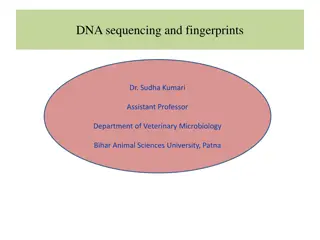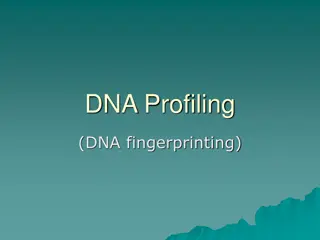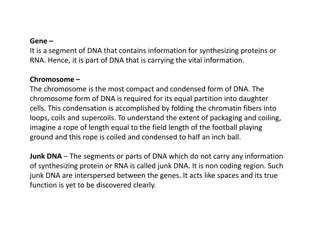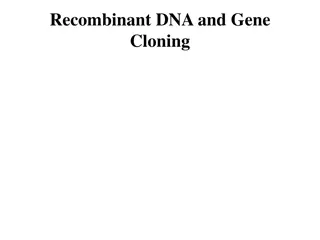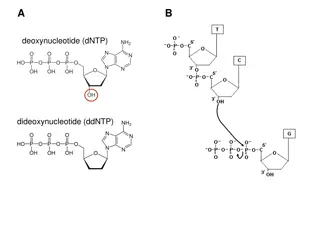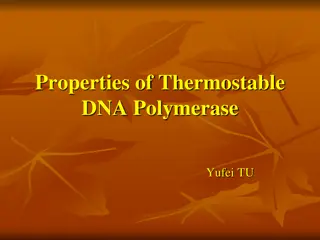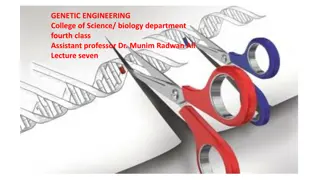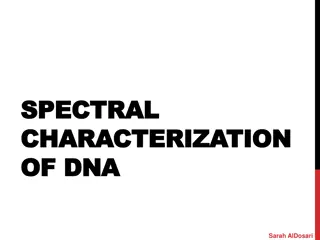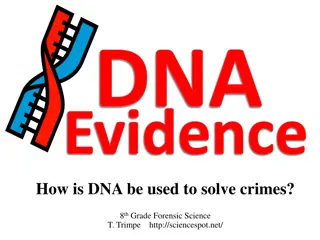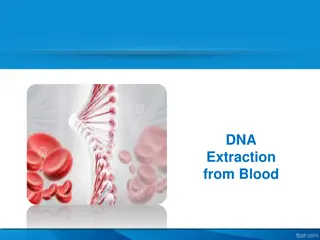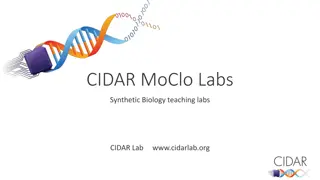Properties and Analysis of DNA in Scientific Research
Learn about the chemical and physical characteristics of DNA, including the hyperchromic effect, UV light absorption, density measurement using cesium chloride, DNA size estimation through electrophoresis, and types of gels for DNA separation. Explore how these properties are utilized for DNA analysis and research purposes.
Download Presentation

Please find below an Image/Link to download the presentation.
The content on the website is provided AS IS for your information and personal use only. It may not be sold, licensed, or shared on other websites without obtaining consent from the author.If you encounter any issues during the download, it is possible that the publisher has removed the file from their server.
You are allowed to download the files provided on this website for personal or commercial use, subject to the condition that they are used lawfully. All files are the property of their respective owners.
The content on the website is provided AS IS for your information and personal use only. It may not be sold, licensed, or shared on other websites without obtaining consent from the author.
E N D
Presentation Transcript
Chemical and physical properties of DNA The hyperchromiceffect
1-ABSORPTION UV LIGHT The bases in DNA absorb ultraviolet light at the wavelength of 260 nm using a spectrophotometer. Free nucleotide basesabsorbed moreultraviolet lightso 1-Free basesabsorb 1.60 units at 260 nm 2-Single stranded DNA absorb 1.37 unitsat 260 nm 3-Doublestranded DNA absorb 1.00 units at 260 nm For that , DNA CONCENTRATION could be determined according to its ability to absorb ultraviolet light ( more DNA present in specific preparation the higher absorption occurred). DNA concentrations can be estimated by comparing its absorption to known concentrations of DNA DNA most be fairly pure, since many contaminating substances (e.g., proteins) also absorb around this wavelength (protein absorbed uvat 280)
2-DENSITY Density can be measured by(CESIUM CHLORIED ) CsCl-density ultracentrifugation ultracentrifugation, will form a density gradient, with thedensestsolution at the bottom Macromolecules, such as DNA, will concentrate in the area of CsCl that has the same density as themselves , more dense DNA will migrate downward and less dense DNA upwards forming bands. Density can be used to estimate G+C content,GC base pairs are denser than AT base pairs Therefore, DNA with more GC base pairs will form bands lower down than an equal number of base pairswith high ATcontent .CsCl, upon
3- SIZE A -Electrophoresis =DNA has a negative charge phosphates in the sugar-phosphate backbone =If DNA is placed in an electrical field it will migrate towards the positive electrode (the cathode) =If DNA is electrophoresed through a gel, smaller pieces will migrate faster than larger pieces =Larger pieces have trouble squeezing through the gel matrix and are hence retarded while smaller pieces migrate easier = The size of DNA is estimated by comparing its migration through the gel to DNAmolecules of known size(DNAladder) due to the negatively charged
Type of gels =Agarose is a polymer of natural origin. It is derived from seaweed.it is used to separate fairly large DNA molecules up to 5 million to a few thousands base pairs =Poly acrylamide is used to separate small pieces of DNA hundred base pairs) B: Electron microscopy The size of DNA molecules can be determined by electron microscope. The DNA is visualized on a grid of known size so that the size of the DNAmolecule can be estimated C-Velocity sedimentation Sedimentation velocity is dependent upon two variables: density and shape The more dense the DNA the quicker it will sediment upon centrifugation Globular (more compact) molecules will sediment faster than linear molecules ( several
4-SOLUBILITY RNA is more soluble in aqueous solutions than DNA . Ribose has a 2'-OH group which is polar and dissolve in water better where deoxyribosecontains a 2'-H Hydroxyl groups C-H is a non-polar bond and is therefore hydrophobic RNA is less stable than DNA because The hydroxyl group on the 2' carbon of ribose is more reactive than hydrogen found in deoxyribose
5-DENATURATION Definition: DNA is considered denatured when the double stranded DNA molecule is converted into two single stranded molecules This can be monitored by noting the increase in absorption of ultraviolet light .Factorscauses DNA Denaturation A-pH Acids pH lower than one (pH=1)result in the breakage of phosphodiester bonds between nucleotides and breakage of the N-glycosidic bond between the sugar and purine bases pH of around 4 results in the selective breakage of N- glycosidic bonds betweenthesugarand purines DNA treated this way is referred to a apurinic acid, since thepurines have beenremoved Alkali Base tends to change the polarity of groups involved in hydrogen bonds Above pH 11.3, all hydrogen bonds are disrupted and the DNA is totallydenatured DNA is resistant to hydrolysis toaboutpH 13 RNA is hydrolyzed intoribonucleotidesaround pH 11
B- Ionic strength DNA sugar-phosphate negatively charged DNA in distilled water will spontaneously denature into single stranded DNA Salts that dissociate into ions will neutralize thechargesof thephosphategroups Salts will stabilize the DNA double helix resulting in a higher Tm The phosphates of the backbones are
C-Temperature =As thermal energy increases, the frequency of hydrogen bonds breaking between the molecules =When the temperature increases, the two molecules will separate into single-stranded molecules =The Tm (melting temperature) of a DNA molecule is the temperature in which half the DNA molecules are denatures =The Tm is used to estimate the G+C content of a DNA molecule G-C base pairs are held together by three hydrogen bonds A-Ts by two and it therefore takes more energy (higher temperatures) Estimating G+C content G+C content of a DNA molecule can be estimated from its thermal melting temperature (Tm)
Hyperchromic effect ( Nucleic acid thermodynamics): is the study of how temperature affects the nucleic acid structure of double stranded DNA (dsDNA). The melting temperature (Tm) is defined as the temperature at which half of the double DNA strands will convert to random coil or single- stranded (ssDNA) state. Tmdepends on the length of the DNA molecule and its specific nucleotide sequence. DNA, when in a state where its two strands are dissociated (i.e., the dsDNA molecule exists as two independent strands), is referred to as having been denatured by the high temperature
Heating double stranded nucleic acids causes the strands to unwind (denature) by disrupting the ordered stacking of the bases and breaking hydrogen bonds. The process can be conveniently monitored by an increase in UV absorbance as the double strands unwind to single strands (owing to hypochromicity). The thermal denaturation of double-stranded DNA is progressive and the concerted melting of the whole structure occurs at a well-defined temperature, corresponding to the mid- point of a smooth transition. This temperature is known as the melting temperature (Tm) .
RENATURATION STUDIES DNA that has been denatured will often come back together when the condition is reversed. This is referred to as renaturation and it occurs because hydrogen bonds of complementary base pairs reformSlowly lowering the temperature or adding ions to a solution may lead to renaturation Renaturation rates are dependent on DNA concentration The more molecules of complementary DNA molecules present, the faster they can find each other and renature DNA molecules in low concentration in solution will take awhile to find a complementary partner, and will therefore renature slower
